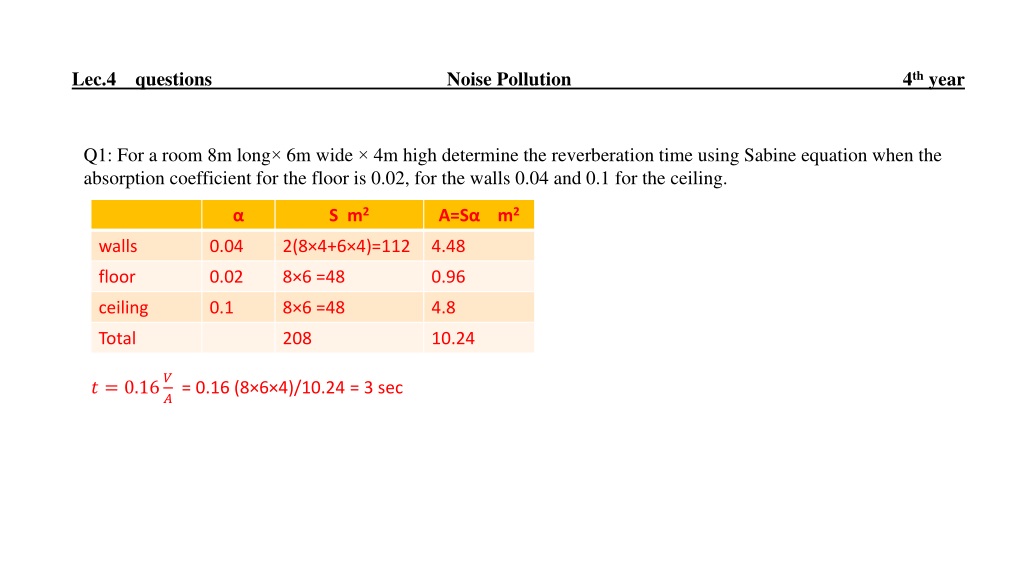

0 likes | 14 Views
Determine reverberation times using the Sabine equation for various room setups, such as different absorption coefficients for floor, walls, and ceiling. Calculate additional sound absorption needed to achieve desired reverberation times and estimate reverberation times in different scenarios, like the presence of people in a boardroom. Also, calculate effective R values for partitions based on door and window properties.

E N D
Lec.4 questions Noise Pollution 4thyear Q1: For a room 8m long× 6m wide × 4m high determine the reverberation time using Sabine equation when the absorption coefficient for the floor is 0.02, for the walls 0.04 and 0.1 for the ceiling. S m2 m2 α A=Sα walls 0.04 2(8×4+6×4)=112 4.48 floor 0.02 8×6 =48 0.96 ceiling 0.1 8×6 =48 4.8 Total 208 10.24 ? = 0.16? ?= 0.16 (8×6×4)/10.24 = 3 sec
Q2: In order to reduce the reverberation time in the room in the Q1 the floor is covered with carpet having an α value of 0.8 in a particular frequency band, the walls are lined with sound absorbing material with an α value of 0.2, and the ceiling is covered with acoustic tiles with an α value of 0.3, in the same frequency band. Calculate the reverberation time of the room. S m2 m2 α A=Sα walls 0.2 2(8×4+6×4)=112 22.4 floor 0.8 8×6 =48 38.4 ceiling 0.3 8×6 =48 14.4 Total 208 75.2 ? = 0.16? ?= 0.16 (8×6×4)/75.2 = 0.408 ≈ 0.41 sec
Q3: A concert hall has a volume of 60000 m3and internal surface area of 42000 m2with an average α of 0.02. Estimate the reverberation time a) assuming surface absorption alone b) including air absorption at 4 kHz and 60% humidity (k value = 20 ×10-3) a) t=0.16(60000)/(42000 ×0.02) = 11.4 sec b) t= 0.16(60000)/(42000×0.02 +60000×20 ×10-3 )= 4.7 sec Note: for the very largest spaces (e.g. cathedrals and very large concert halls) air absorption might become significant at high frequencies. Reverberation time with air absorption : 0.16? ? = ? × ?????+ ?? k is humidity and frequency dependent
Q4:Aworkshop of dimensions 8m long× 6m wide × 4 m high with hard sound reflecting surfaces is to be refurbished as a room for meetings. The reverberation time is measured and found to be 3.0 seconds in a particular octave band. Calculate how much extra sound absorption must be introduced into the room in order to reduce the reverberation time to 0.8sec, suitable for speech. If this is to be achieved using carpet on the floor with an α value of 0.2 in the same band and by covering areas of the wall and ceiling with sound absorbing panels have an α value of 0.4, calculate the area of these panels which must be used. Existing amount of absorption, A=0.16(8×6×4)/3 = 10.24 m2 Amount of absorption needed for required t value of 0.8sec , A= 0.16(8×6×4)/0.8 = 38.4 m2 Therefore, additional absorption required = 38.4 – 10.24 = 28.16 m2 Additional absorption due to carpet = Sα = (8×6) 0.2 = 9.6 m2 Therefore, additional absorption, A, required from sound absorbing panels = 28.16 – 9.6 = 18.56 m2 Since A= Sα → S=A/α = 18.56/0.4 = 46.4 m2...... Therefore, an area of 46.4 m2of acoustic panels are needed
Q5:Aboard room of volume 150m3has a reverberation time of 0.8sec when empty. Estimate the reverberation time during a board meeting when 12 people are present. Assume an absorption of 0.45m2per person in the required octave band. ? ?ℎ?? ????? = 0.16 ×150 ? ?ℎ?? ???????? = 30 + 12 × 0.45 = 35.4 ?2 ? ?ℎ?? ???????? = 0.16 ×150 0.8= 30 ?2 35.4= 0.68 ??? Q6: In a large hall or theatre the total amount of sound absorption is often determined by the amount of sound absorption provided by the seats and audience which may far exceed the absorption produced by the remaining fabric of the building. If the amount of absorption per seat is 0.5m2in a certain octave band, estimate how many seats may be accommodated in a hall of volume 2000m3if the reverberation time is not to fall below the optimum required value of 1.0 sec. ? = 0.16 ×2000 1.0 ?? ?ℎ? ??????? ?????? ?? ????? =320 0.5= 640 = 320 ?2
Q7: A partition between two rooms has dimensions 6m×3m and contains a door of dimensions 2m×1m and two windows, each of dimensions 1.5m×1m. In a certain octave band, the wall has an R value of 45dB, the door of 35dB, and the window of 20dB. Calculate the effective or average R value of the partition. R value dB t = 10-R/10 Area S m2 St Element Wall 45 3.16 ×10-5 (6×3-2×1-2(1.5×1))=13 0.000411 Door 35 3.16 ×10-4 2×1=2 0.000632 Glass 20 1 ×10-2 2(1.5×1) =3 0.03 Total 18 0.0310 ?1× ?1+ ?2× ?2+ ⋯ ?? 1 ????? 0.031 18 ?????= = = 0.00172 ?????= 10 ??? = 27.6 dB